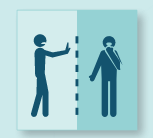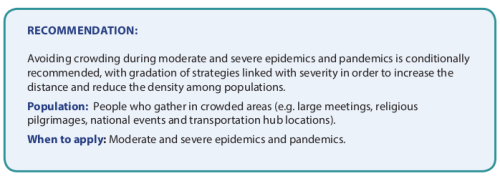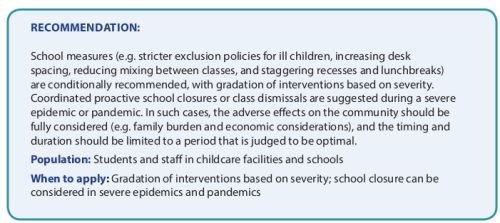 |
| Credit WHO |
#14,508
I suspect that tying to come up with a one-size-fits-all guidance document on Non-pharmaceutical Interventions (NPIs) for the next influenza pandemic may be one of the most thankless jobs in public health policy making.
No matter what is produced, few are going to be 100% happy with the product, and in all likelihood, many of the recommendations will be heavily modified - if not outright ignored - during the next pandemic.NPIs - or Non-Pharmaceutical Interventions - are those actions (apart from taking vaccines & antivirals) that individuals and communities can do to help slow the spread of an infectious disease.
Last Friday, in WHO Guidance: Non-pharmaceutical Public Health Measures for Mitigating the Risk and Impact of Epidemic and Pandemic Influenza, we took our first look at the World Health Organization's recently released 91-page NPI Guidance document.
Two days later, in The WHO NPI Guidance : Personal Protection, we looked at the WHO personal protection NPI recommendations for hand hygiene, respiratory etiquette, and the use of (surgical) face masks across a range of pandemic severities.As I pointed out, some their recommendations - particularly those regarding the use of disposable surgical face masks - will probably face considerable push back. But I suspect the authors understood that going in.
Today we wander into an even bigger minefield; social distancing.The goal of NPIs is slow transmission in order to `flatten the epi curve', not to stop a pandemic (see chart below). While it probably won't make much of a difference in the number of illnesses, or deaths, by spreading them out over a longer time period you can hopefully reduce the impact on society.
The first reaction for many people during a severe pandemic is probably to stay home, hunker down, and avoid contact with others. A reasonable course, I suppose, if a pandemic wave were to last a few days, or a week or two.
But most pandemic waves will run 6 to 12 weeks, perhaps longer, and few people are prepared to shelter in place for 3 months. And even if they could - if enough people did so - society would collapse.As deadly as a pandemic might be, if we can't keep the food supply chain running and the store shelves filled, the lights on, potable water flowing, hospitals open, gas pumps operational, the streets safe, and a thousand other essential services intact, the death toll could be many times greater.
Collateral damage due to a breakdown in essential services could easily claim more lives than the pandemic virus.Social distancing is one of the tools can can help keep people safer while still going to work, or school, or engaging with other members of their community. The WHO NPIs for social distancing are phased according to the pandemic's severity (see red-boxed items in list below).
Isolation of sick individuals (some in hospitals, but most cared for at home) is recommended for any severity of epidemic or pandemic, and ought to be the least controversial, but every flu season we see millions of symptomatic people go to work, or to school, or out in public.
Employers often tell sick employees to stay home if they are sick, only to penalize them for doing so. This, unfortunately, is particularly common in healthcare settings (see A Hospital Is No Place For A Sick Person).I described an encounter with a (very) symptomatic cashier during the 2009 H1N1 pandemic in Being A Sneeze Guard, and I expect presenteeism will be as big of a problem as absenteeism during the start of the next pandemic.
Moving up the pandemic severity ladder, for moderate pandemics the WHO adds a conditional recommendation for avoiding crowds, writing:
It isn't until we reach a high severity pandemic that the WHO pulls the trigger on school closings, and by that time, I suspect the point will be moot. Many parents will begin pulling their kids out of class even in a moderate pandemic, when the absentee rate of students and staff due to illness will likely already be high.
Workplace closures are reserved for only the most extreme pandemics, although lesser measures (teleworking, staggering shifts, etc.) may be implemented earlier. This assumes of course that people will be willing to go to work during a high severity pandemic, and we've seen polls suggesting many people may not.
Finally, among the measures not recommended by WHO for any severity are:
- Contact Tracing
- Quarantine of Exposed Individuals
These NPI recommendations are for an Influenza Pandemic, and not all of them would apply for a non-influenza pandemic, such as due to MERS-CoV, SARS, Nipah, or `Clade X'.
Contact tracing may be appropriate for the first few outbreaks, but once the viral genie is out of the bottle, it become of little more than academic value.
SARS was contained, in large part, due to highly aggressive quarantining of exposed individuals. A 2003 MMWR report from China’s CDC, called Efficiency of quarantine during an epidemic of severe acute respiratory syndrome--Beijing, China, 2003 found:
The use of quarantine, in combination with enhanced surveillance, isolation of SARS patients, and comprehensive use of PPE by health-care workers, appears to have been effective in controlling the recent epidemic of SARS in Beijing.
Limiting quarantine to persons who have contact with an actively ill SARS patient will likely improve the efficiency of quarantine and allow for better focus of resources in future outbreaks.
But influenza can be spread by completely asymptomatic carriers, making quarantines basically useless. That said, I would have like to have seen a recommendation that anyone caring for a sick individual at home - if at all possible - try to avoid spreading the virus by voluntarily staying home.
No, it won't be practical for everyone. But I'd try to do it, and if the goal is to reduce (not stop) the spread of a pandemic virus, I think it would have some impact.The truth is, an influenza virus with a typical R0 (r-naught, or basic reproductive number), will be impossible to stop. Social distancing, border closings, self quarantine, and travel bans might slow its progress, but it won't prevent it.
The goal is to find ways to reduce a pandemic's impact, without causing more harm. While not perfect, or applicable across the board, these NPI recommendations provide a reasonable starting framework going into the next pandemic.But as any soldier will tell you, no battle plan survives first contact with the enemy.




